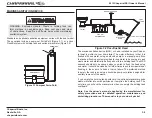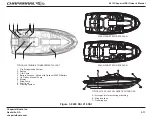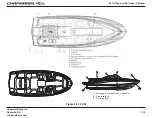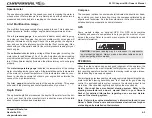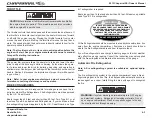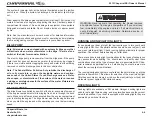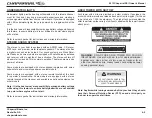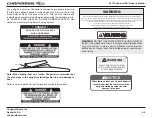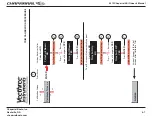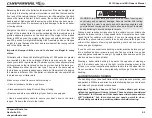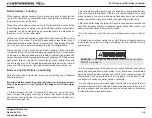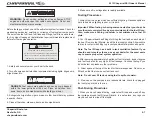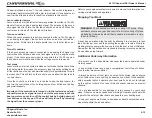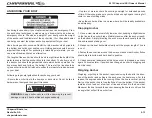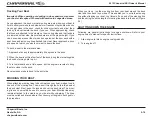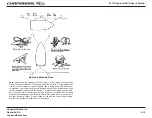
2013 Chaparral SSi Owner’s Manual
Chaparral Boats, Inc.
Nashville, GA
chaparralboats.com
5-2
Balancing the load on the trailer is also important. If too much weight rests
on the hitch, the towing vehicle will oversteer, a condition that causes the
front end of the vehicle to sway. Conversely, too little weight on the hitch
causes the trailer to fi shtail. In both cases, the vehicle will be diffi cult to
handle and at higher speeds the swaying or fi shtailing can become un-
controllable and result in personal injury and damage to the boat, trailer,
or towing vehicle.
Weight on the hitch, or tongue weight, should be 5% to 10% of the total
weight of the loaded trailer to avoid overloading the tow vehicle and to
provide adequate pressure on the hitch ball. If the weight of the loaded
trailer is 2000 pounds, the weight on the tongue should be between 100
and 200 pounds. A weight distributing hitch transfers portions of tongue
weight to a point between the front and rear wheels of the towing vehicle
and to the trailer wheels.
Important: Bumper hitches are not safe and are illegal in many
states.
All trailers with a Gross Vehicle Weight Rating of 1500 pounds or greater
are required by law to have brakes. (State laws may vary; be sure to
check your state’s requirements.) The brake system is usually completely
self-contained on the trailer and no hook-up is required to the towing ve-
hicle. Brakes are either drum or disc type. They work the same way as
the brakes on a standard passenger vehicle, but the method of applying
the brakes is different. Your Chaparral or trailer dealer can explain how
the brakes on your trailer work.
Make sure your boat is secure before towing it.
• Close all windows, hatches, and doors.
• Store equipment to keep it from shifting or falling.
• Remove and store convertible top if your boat is so equipped.
• Use a second safety chain to secure your boat’s bow to the trailer
tongue. Tie down the stern to the trailer.
Towing a boat requires extra caution by the vehicle’s driver. Allow extra
distance between vehicles. Obey speed limits. Some states have lower
speed limits for vehicles with trailers. If you are traveling slower than
other traffi c, pull over when it is safe to do so and allow traffi c to pass. As
with all other aspects of owning and operating your boat, use common
sense and good judgment.
If you do not have experience backing a trailer, practice before you get
into a confi ned public or private launch site. Take your trailer to an open
area and get accustomed to using it. If possible, take someone with you
who knows how to back a trailer.
Steering a trailer while backing it up works the opposite of steering a
car. If the trailer needs to go to the right, turn the steering wheel to the
left and vice versa. Inexperienced backers tend to turn the wheel too far.
Do not oversteer. Turn the wheel gradually until you get the feel of safe
backing.
WARNING: Improper towing can result in an accident causing per-
sonal injury and equipment damage. Become familiar with towing
instructions in owner’s manuals and with warnings supplied with
your trailer and towing vehicle. Insure all snap-in carpet is stowed
during trailering to avoid damage to carpets.
LAUNCHING AND LOADING
The handling of your boat and trailer at the ramp requires practice, skill
and patience. With care and attention to the following tips, you can launch
and relaunch your boat with relative ease.
Important: Typically a beam of 8 feet 6 inches allows you to tow
without a special permit in most places. These boats are considered
”trailerable” for this reason. Other boats have wider beams and are
still “trailerable,” but, in most cases you need a permit to do so.
Check with your state on permit requirements before towing.


